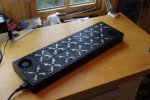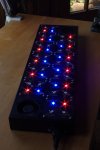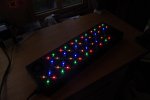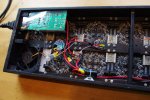Andrew Cowan
Senior Member
One of my latest projects is a RGBY LED floodlamp (for lack of a better word).
I've built a wooden box which houses twelve 4W RGBY (red, green, blue, yellow) LED modules. These have built in constant current drivers with PWM. Control will most likely be a 28X2.
Power is provided by a decased 12V 5A power supply. A 60mm fan blows air through the whole thing - the speed of which is controlled by an 08M and thermistor. The unit plugs into 240v through an IEC socket in the side.
I'm hoping to do the communication and control to it through RF wireless. The range needs to be no more than 10 meters or so (inside), so nothing to complex. I decided to make use of PICAXE's new rfin and rfout commands, so I stuck a bog standard 434MHz AM receiver into it. Sending a message between my AM modules on breadboard was fine - however...;
When installed in the unit, communication is intermitant. When the LEDs are turned on, the communication never gets through and the unit doesn't respond.
To troubleshoot this, I first hooked a scope to the supply of receiver. The result is about 30mV of ripple in the supply, at a few hundred hertz. While not ideal, I do think why this isn't working.
I next turned on a high quality amateur radio, tuned to 434Mhz. When the floodlight is not plugged in, there is the usual background buzz. When the floodlight is plugged in, the radio is filled with buzzing and static at a much higher volume. When the LEDs are turned on, it gets even louder.
Conclusion: Somewhere, this unit is generating a lot of noise at 434MHz. It could be the switching power supply, the LED drivers or something else - I'm not sure. But it's very apparent that my AM modules are not going to be any use for this project.
I could switch to FM modules, as these have much better performance in noisy environments. However, I have a feeling that the performance would still be dodgy and intermittant - there's a lot of noise.
IR is not a possible solution, although not ideal for this project. I think I'll keep it as a in-case-everything-else-fails idea...
I'd be very interested to hear any thoughts on the matter! I have a feeling that 2.4GHz modules (such as xbees) would perform better in this situation - has anyone any recommendations on what 2.4GHz modules are any good (and cheap)?
A groundplane/shielding around the module may help, but I'd be very interested in an off the shelf solution.
Thanks for any ideas!
Andrew
I've built a wooden box which houses twelve 4W RGBY (red, green, blue, yellow) LED modules. These have built in constant current drivers with PWM. Control will most likely be a 28X2.
Power is provided by a decased 12V 5A power supply. A 60mm fan blows air through the whole thing - the speed of which is controlled by an 08M and thermistor. The unit plugs into 240v through an IEC socket in the side.
I'm hoping to do the communication and control to it through RF wireless. The range needs to be no more than 10 meters or so (inside), so nothing to complex. I decided to make use of PICAXE's new rfin and rfout commands, so I stuck a bog standard 434MHz AM receiver into it. Sending a message between my AM modules on breadboard was fine - however...;
When installed in the unit, communication is intermitant. When the LEDs are turned on, the communication never gets through and the unit doesn't respond.
To troubleshoot this, I first hooked a scope to the supply of receiver. The result is about 30mV of ripple in the supply, at a few hundred hertz. While not ideal, I do think why this isn't working.
I next turned on a high quality amateur radio, tuned to 434Mhz. When the floodlight is not plugged in, there is the usual background buzz. When the floodlight is plugged in, the radio is filled with buzzing and static at a much higher volume. When the LEDs are turned on, it gets even louder.
Conclusion: Somewhere, this unit is generating a lot of noise at 434MHz. It could be the switching power supply, the LED drivers or something else - I'm not sure. But it's very apparent that my AM modules are not going to be any use for this project.
I could switch to FM modules, as these have much better performance in noisy environments. However, I have a feeling that the performance would still be dodgy and intermittant - there's a lot of noise.
IR is not a possible solution, although not ideal for this project. I think I'll keep it as a in-case-everything-else-fails idea...
I'd be very interested to hear any thoughts on the matter! I have a feeling that 2.4GHz modules (such as xbees) would perform better in this situation - has anyone any recommendations on what 2.4GHz modules are any good (and cheap)?
A groundplane/shielding around the module may help, but I'd be very interested in an off the shelf solution.
Thanks for any ideas!
Andrew
Attachments
-
943.3 KB Views: 30
-
867.6 KB Views: 33




